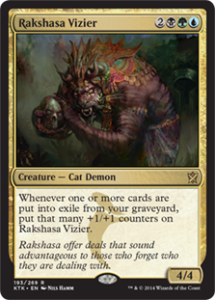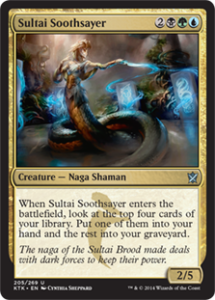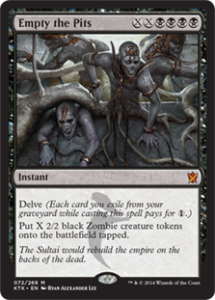The Sultai Brood, like last week’s Jeskai monks, owes its inspiration to a civilization from our history that existed at odds with the Mongol Empire. While the Jeskai borrow heavily from spiritual and philosophical traditions of medieval China, the Sultai reflect the cultural inheritance of the Khmer Empire of Cambodia—a kingdom of vast cities, ornate temple-palaces, and mighty armies in the 13th century.
The Khmer empire and its ruling dynasty existed long before the Golden Clan of Chinggis Khan. According to their subjects’ beliefs, the Khmer royal family owed its authority to divine right through the Hindu pantheon (especially Siva and Vishnu) following their successful overthrow of Javanese rule in the early 9th century CE. While the Mongols, as a nomadic people, left few monuments to their triumphs, the theocratic rulers of the Khmer Empire built a series of breathtaking wonders to exalt their royal line. Here in the lush Indochinese peninsula, the Khmer dynasty left two lasting testaments to its power and splendor: the largest pre-industrial city in the world in Angkor, and the largest religious monument in the world in Angkor Wat.

Aside from the immense archaeological evidence from the sites of Khmer rule and power, the greatest glimpse we have into the ordinary daily lives of their civilization and subjects comes from the records of the Mongol Empire. In 1296 CE, a Chinese diplomat named Zhou Daquan was dispatched by Temur1 Khan, Mongol ruler of the Yuan Dynasty, likely with a demand that the Khmer ruler pay tribute. His account amongst the Cambodian people reveals a society of merchants, farmers, and artisans living in a vast urban society beneath the temple complexes and jungle canopies of the Indochinese peninsula.

Angkor Wat in Cambodia – temple complex and later mausoleum of Khmer royalty.
Angkor was a marvel of architecture and organization, even by the standards of a scholar from the heart of sophisticated southern China. Daquan relates that farmers cultivated terraced gardens and artificial waterways for transport and irrigation, while a vast mercantile culture thrived upon the extravagance of the Khmer ruling class. Of great interest to the Chinese emissary was the social power and wealth of women in Cambodian society. Women freely bathed in the artificial rivers of the Khmer capital, attended Buddhist ceremonies atop elephants and chariots, and completely ran the markets in Angkor’s central squares.2 Daquan even credited King Indravarman III’s principle wife as the reason for her husband’s rise to power.
As in the other clans of Tarkir, the religious and spiritual beliefs of the Cambodian peoples under the Khmer dynasty are reflected in the magic of the Sultai. Rakshasa and naga both appear in Hindu religious scripture, as well as art in Cambodia and southeast Asia during the medieval period.
Rakshasa were believed to be born of the exhalation of the ultimate progenitor of human life in the Hindu faith. True to their perfidious depiction on Tarkir, they immediately turned upon their creator and derive their name from his desperate cry for help. In Hindu tradition, rakshasa are depicted as fearsome, fanged spirits, capable of powerful illusion and enchantment, allied with the cause of both good and evil in the world.
Naga, while also dangerous, were mostly depicted as benevolent spirits of semi-deific status in Hindu tradition. Royal precursors to the Khmer Dynasty claimed origin from the sacred naga, who aided heroes of the Hindu faith in service to the Cambodian peoples of the ancient era. The naga, like their counterparts on Tarkir, are affiliated with water and changea, and are depicted in statuary as the guardians of treasure like the troves of the Sultai.
In many senses, the achitecture, setting, and magical elements of the Sultai Brood are a clear citation of the Khmer Empire and Cambodian civilization. What is ultimately unclear about the Sultai is the decision to translate all of the elements of their culture taken from our own history—representative of a vast, sophisticated culture and religious tradition that continues to this day in Cambodia and southeast Asia—and make it unquestionably, totally evil.
It cannot be denied that the opulence of the Khmer-era palaces and temples that exist in modern Cambodia speak to an elite ruling class, every bit as autocratic as Sidisi, Brood Tyrant and her naga allies. And it is certainly true that the civilization of the Khmer Empire was very much a slave society, in that the majority of Angkor’s citizens were unfree, bound to families or the ruling dynasty as recorded by Zhou Daquan. It is likely that this system of slavery informs the depiction of undead labor amongst the Sultai, bound inexorably to the whim of their tyrannical masters.
But the Khmer were hardly alone in these ultimately reprehensible cultural legacies. Medieval China, reflected in the Jeskai Way, was a strictly stratified society, with a system of vassalage that could be considered indistinguishable from slavery. The Abzan tradition of krumar makes reference to traditions of slavery throughout the medieval Islamic world. Egypt’s Mamluk Dynasty was founded by former slave armies who outgrew their would-be masters. The Mongol nomads, whose culture and Empire inspired the Mardu and Temur, at least in part earn their reputation for destruction and wholesale slaughter in the medieval period. Throughout their medieval rise and reign, the nomadic Mongols showed little consideration for the lives of their agricultural subjects. In fact, their word for the sedentary civilians of their rivals matched their word for herd animals.
Ultimately, the Sultai build upon a rich, complex tradition of Cambodian civilization and Hindu spirituality, but their depiction on Tarkir as a reflection of our history would lead one to believe that the Khmer were tyrants beyond the pale of their neighbors to the north and west. Similarly, the naga and rakshasa of Tarkir are wildly divergent from their origin in the Hindu faith, which is very much alive and well today. Khmer Cambodia, like the Mongol steppes of central Asia, the Islamic world of the eastern Mediterranean, and the Chinese civilization of the Yuan dynasty, was a sophisticated and extremely accomplished society, whose legacy cannot be summarized as easily as a wedge-colored clan in a set of Magic cards. It is the author’s sincere hope that you get the chance to read Zhou Daquan’s excellent account, or visit the wonders of Cambodian civilization, to explore the Khmer dynasty’s history beyond their depiction by proxy in Magic’s multiverse.
Curtis Wiemann is an old sneaker full of copies of the card Wild Growth (Ice Age edition).
1 Yeah, it’s even a Mongol name. I know, right?
2 Zhou Daquan. A Record of Cambodia: The Land and its People. trans. Peter Harris (Chiang Mai: Silkworm Books, 2007).




